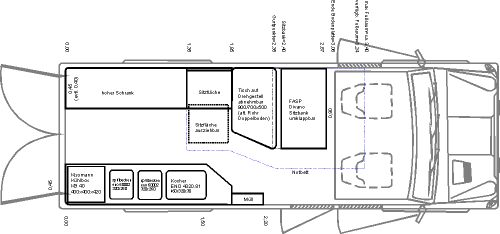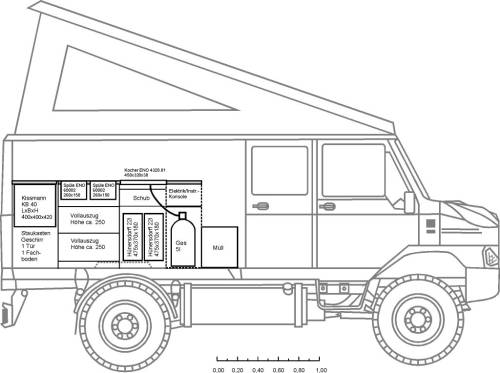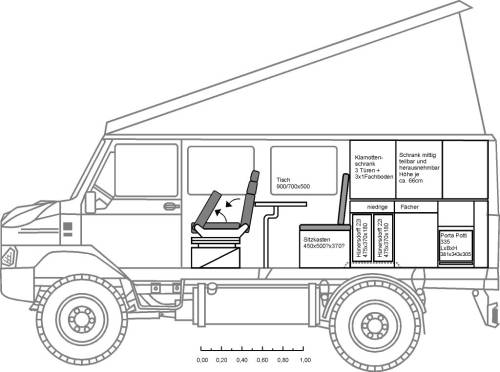| Home | |
| Story of a vehicle selection | |
| Technical / details | |
| Interior dimensions | |
| Conversion | |
Bremach? Story of a vehicle choice
Bremach? I' ve never heard of that vehicle brand before! Where's it coming from, and how on earth did it come into your mind to buy that kind of truck?
Now, a couple of years ago my wife and I started to develop a cunning plan to take a year off from work and hit the road. Then being parents of a toddler girl, we knew we'd better be quick, as there is no such thing as home schooling in our home country and taking kids of school just for travelling purposes is almost impossible.
It took us only a very short time to select the destination for this probably "once in a lifetime" trip. We had very fond memories of two previous Kiwi holidays and met some very lovely Australian people before. Not to mention the travel reports of some of our friends who had spent long time down under.
Since we planned to travel to some of the rather remote spots of the outback, we started to look for a tough 4wd vehicle. Not too large, so that we would be able to tackle the typical bush tracks, but also with enough space for two adults and a child for prolonged travel.
We've done extensive research on the internet to look for an appropriate vehicle, but didn't manage to find what we've been looking for. At that time, the "bushcamper" with a popup roof based on the Toyota HZJ75/78 heavy duty series, would have been our favourite rig if travelling without a child. But the dual passenger seat is very narrow and even though its quite a long vehicle, because of the long bonnet the interior space is rather small. So we gave up on this one.
Next, we thought we might try to find an OKA, but since they had been out of production for quite a while (and ever been quite rare anyway) and also most of them had received more then their fair share of (mis-)treatment, finding one in good nick seemed to be a hopeless effort.
Also buying a vehicle in New Zealand and ship it to Australia to sell it there at the end of our trip was not an option, due to incredibly high customs charges. So shipping the vehicle from Europe became an option, especially, since it is quite inexpensive as long as the vehicle fits into a standard 20' container.
We could have bought various bigger sized 4WD trucks (most of them ex-army) but because they do not fit into a standard container, roll-on roll-off shipping would have been the only solution, and with a big box on the back, shipping costs from Europe at that time would have been easily 12 grand Australian one way! Also fuel consumption of these trucks is high and spare parts are either unavailable down under or incredibly expensive.
By chance we found Bremach. Having spent most of our previous "camping life" in different Volkswagen camper conversions, and always being quite happy with it, this vehicle immediately caught our attention. Basically the same concept, only on big wheels with enormous ground clearance.
After a first visit at Allrad-Christ the female family members have already been completely convinced. Only the male part of the family (if things would come to the worst responsible for repairs) was still a little bit in favour of the legendary reliability of the Toyota. But the idea to buy a vehicle from a dependable and experienced company, that takes care of offroad travellers everywhere on the planet, be it in Chile, Mongolia, Africa or the Simpson desert didn't sound too bad.
Finally after comparing the Bremach with two different Toyota conversion concepts, the decision was made: Bremach.
Technical details Bremach Extreme
Bremachs usually lead a quite boring life as council vehicles, road sweepers, mowers or fire trucks. What's special about them is, that they are quite narrow compared with other vehicles built for similar purposes. Being built in Italy they are perfectly adapted to their home countries conditions as Italian roads are often quite narrow.
Many Bremachs have been used in the German coal mining industry where living conditions are pretty rough for any kind of vehicle. The company only builds around 400 vehicles per year, so even in Italy the aren't seen very often.
Engine, gearbox (by ZF) electronics and brakes are the same as in the Fiat Ducato vans or the IVECO Daily trucks. This engine is currently the base for the majority of all new registered motorhomes in Europe and increasingly getting popular in Australia too. The rest of the vehicle is basically "tractor engineering". Consisting of standard industrial parts that hopefully can be repaired by almost every blacksmith in the middle of Africa.
some technical details are:
- Engine: IVECO aifo 8140.43S, 2,8l 4 cylinder Turbo, 125hp
- Gearbox: ZF 6-Speed
- Transfer case by Bremach, synchronized 2-Level + low range. This makes a total of 24 forward and 4 reverse gears.
- Selectable 4WD (switchable while driving! Now also available as constant 4wd)
- Tubular ladder frame (identical for 3,5 and 6 ton version)
- Live axles, leaf springs
- Special army type split rims, with tubeless tyres(!) Michelin 255/100 R16 (9.00 R16)
- Mechanical front and rear differential locks.
- Weight of unladen vehicle before conversion of interior ca. 2800kg
- Weight of unladen vehicle after conversion of interior ca. 3200kg
- Fuel tank capacity 2 x 135l
- Dimensions LxWxH 5.60 x 1.77 x 2.56m
More details on the website of Allrad-Christ.
With 1,77m the Bremach is a few cms narrower than a Volkswagen van a Troopie or a Landrover Defender. Anyway it provides sufficient interior width to use it as a camper, because it's build like a real box and not getting narrower towards the top. So while the bed in the roof of our Volkswagen was only 1.08m wide, the Bremach offers a comfortable width of 1.35m.
The usable length behind the front seats is about 3.10m so roughly 20cm/60cm longer than in a Volkswagen with short/long wheelbase.
We took a long time planning the conversion, had a look at all sorts of motorhomes, conventional campervans and 4WD conversions and developed the layout shown below. After 12 months of living in it, we have been completely satisfied with it, the only thing we've been lacking after a while was storage space due to the the ever increasing amount of childs toys we had to carry. Therefore we had an additional storage boxes mounted underneath the vehicle in Hobart.
View from above:
- The vehicle seats four people. The double seat behind the driver's seat has a forward or backward seating position or can be turned down for sleeping. A feature we only used, if stormy whether prevented us from opening the popup roof. This only occured three times during our one year journey.
- The kitchen has a Resopal surface, which is easy to clean, scratch-resistant and withstands high temperatures.
View from the right hand side:
- Initially we wanted to use a diesel stove built by Wallas, but finally we decided to use a gas-stove from eno-marine, because it's easy to adjust and doesn't have any electronics.
- Our water supply is based on 4 x 22l PVC "wide neck" cans by Hünersdorff. In addition to that we can increase the amount of water carried, by using 20l rubber bags from the swiss army.
- The compressor fridge is build by Kissmann.
- The sinks are marine models, which are deeper than the usual ones used in motorhomes.
View from the left hand side::
- The chemical toilet (Porta-Potti) is placed on a heavy load drawer that holds 120kg)
- Der cupboard is divided in the middle, so the upper part can be taken off or placed in the aisle, to create an even surface to create an extra emergency bed for a child.
to be continued...


